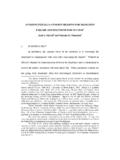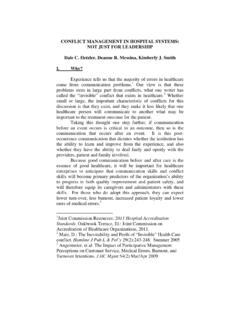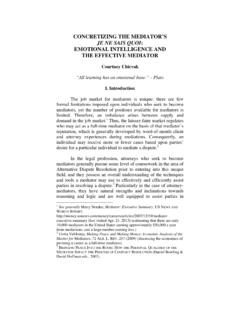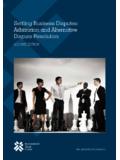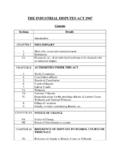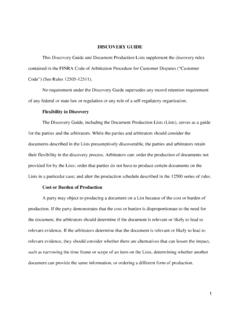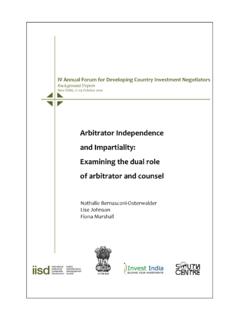Transcription of ELECTRONIC DISCOVERY: WHY THE APPOINTMENT OF SPECIAL ...
1 ELECTRONIC discovery : WHY THE APPOINTMENT OF SPECIAL MASTERS. IN ALL LARGE ELECTRONIC discovery . disputes IS VITAL TO THE PROGRESS OF. AMERICAN CIVIL JUSTICE. Zachary Parkins Part 1: Introduction The Federal Rules of Civil Procedure begin simply enough, stating in the opening rule that all following rules should be construed and administered to secure the just, speedy, and inexpensive determination of every action and proceeding. 1 Therefore, the main goal of litigation should not be to push away those that cannot easily afford adjudication and, instead, should be to foster equal opportunity inside the court This rule, utopian enough on its face, becomes even more so when faced with terabytes3 of information found on multiple servers from Orlando, Florida to Moscow, Russia. The speedy and inexpensive determination articulated in Rule 1 is put in direct conflict with the time and expense associated with retrieving and reviewing ELECTRONIC documents from around the world and preparing for trial.
2 The current system of discovery , as proposed in the Federal Rules of Civil Procedure,4 does not go far enough in regards to ELECTRONIC discovery . They are etched into an outdated system that will not work when, instead of hundreds of boxes of paper, there is the potential for millions of boxes. The system in place does not assure a speedy and inexpensive determination in lawsuits, and therefore the system must be modified. 1. FED. R. CIV. P. 1. 2. Equal opportunity inside of the court room is a well intentioned goal that will never be reached. 3. A Terabyte of information is equal to 50,000 trees worth of printed information. 4. The current rules on discovery are found beginning at FED. R. CIV. P. 26 and end at FED. R. CIV. P. 37. After being hired as an advisor to the Federal Rules Advisory Board, I have been tasked with devising a system to return discovery to a reasonably priced model, ensuring the ability of the relevant facts to be determined while also allowing the adversarial system to continue in place.
3 The solution devised involves the appointing of an ELECTRONIC discovery Master (EDM) to litigation cases when the amount in controversy in a federal civil case reaches a specified This will aid the proceedings in countless ways, but most importantly, it will provide the court with the ability to once again provide justice in an efficient, effective and economical way. This paper is broken into six parts. Part I provides an introduction to the context and bigger picture in which this system will fit. Part II explains who the stakeholders are in this system, and why they have a strong interest in a successful resolution plan. Part III examines the current discovery system employed in litigation and the problems, inherent in the system, that present far reaching problems for discovery as a whole. Part IV discusses the proposed design system to improve the current ELECTRONIC discovery pitfalls, discussing both the advantages to the new system, as well as the potential problems with the proposed changes.
4 Part V briefly touches on ethical issues present inside the designed system. Finally, Part VI. concludes by providing a precise summary of why the old system is flawed and why the adoption of the proposed system will save time and expenses while providing a more fair adjudication process, and also touches on the support that systems like the one designed have already begun to receive from the ELECTRONIC discovery community. Part II: Stakeholders A design system reaching and amending the current processes of the federal courts will have numerous stakeholders who all have something to gain, or lose, with the proposed system. First, there are parties in many litigation matters who are often subject to power-based resolution, meaning that more wealthy litigants often control the entire process, dictating the court through usage of monetary funds. This new system will put litigants in a much more fair position in this regard.
5 As Justice Murphy declared in Hickman v. Taylor, [m]utual knowledge of all the relevant facts gathered by both parties is essential to proper litigation. 5. The threshold will be determined by different circuits, but when the amount in controversy is at least $1 million, there will be a mandatory $30,000 retainer fee for a qualified EDM. Additionally, the maximum that will be paid for a retainer of an EDM is $150,000, which will only qualify for cases with more than $25 million in controversy. To that end, either party may compel the other to disgorge whatever facts he has in his possession. 6 While useful in theory, the advancement of technology has made the process much more burdensome to non-wealthy litigants. Therefore, the proposal attempts to equalize the power to some extent, both in a monetary and legal fashion, among litigants in a practical manner. Additionally, many members of the judiciary and the court system overall have likely been hoping for a resolution such as this for years.
6 Judges, and the federal court system, have enough going on7 without completely learning a new way of working through discovery . Many judges do not have the time or the patience to fully educate themselves on the many intricacies of e- discovery . The proposed system answers these demands, both allowing the judges to focus on the bigger picture in e- discovery cases, while providing a valuable confidant already well educated in this specialized area of law who can educate the judge on the necessary points in a given controversy, granting relief to the entire federal court system. Additionally, litigation attorneys from large firms, who have spent years honing their craft, may well take exception to this new system which forces a third party neutral into adversarial proceedings. These attorneys may well see the EDM as an enemy to their cause, standing in their way of winning' a case. However, the EDM should not be seen as such.
7 Since the goal of discovery is to make sure both parties have the accurate facts of a case, attorneys should be pleased that an EDM has been tasked with making that process more effective and efficient. Finally, this system will have an impact on education in law school as well as those who become EDMs. This system design is only being brought about because there has been a huge failure to adequately educate in law schools, and law firms, throughout the country. Many practicing attorneys do not even understand the intricacies of e- discovery , and many judges are unable to determine if parties, or even themselves, are being taken advantage of because they also have not received adequate training. Therefore, this system can, in the end, add a benefit to the educational levels at law schools, ensuring that the basics of ELECTRONIC discovery are 6. Hickman v. Taylor 329 495, 507 (1947). 7. The average District Court Judge has more than 400 new cases filed every year that must be dealt with in an effective and efficient manner.
8 ( ) covered during Civil Procedure. In the mean time, this design system opens a niche area to those who do understand the full scope of ELECTRONIC discovery , and are willing to offer that knowledge for a specified retainer. Part III: The Current E- discovery System The Federal Rules of Civil Procedure outline the entire scope of discovery inside civil litigation. After initial filings, parties are to meet and confer through a FED. R. CIV. P. 26(f) conference. At that conference, a plan for discovery , both ELECTRONIC and paper, is to be discussed, formulated and agreed upon by the parties. After this plan is determined, the parties themselves are put in charge of discovery , and interaction by a judicial figure is limited to serious party disputes . Therefore, when problems are, in fact, brought before a judge, they are generally taken as very severe matters. These problems can well be magnified when involving SPECIAL masters are appointed under FED.
9 R. CIV. P. Rule 53: The problem inherent in this system, and exasperated by ELECTRONIC discovery , is that a SPECIAL master appointed under FED. R. CIV. P. 53 is ordinarily appointed after problems have already arisen. Often, millions has been spent throughout a litigation only to find that evidence has been hidden, or worse, destroyed. The current E- discovery system, and specifically FED. R. CIV. P. 53, are far too reactive to effectively monitor ELECTRONIC discovery . For example, in Hohider v. United States Parcel Service, Inc. a SPECIAL master was appointed to the process only when the plaintiffs in a disabilities class action claimed that three years of electronically stored 8. FRCP 53 (a) allows a judge to appoint a SPECIAL master to: (A) perform duties consented to by the parties; (B) hold trial proceedings and make or recommend findings of fact on issues to be decided without a jury if APPOINTMENT is warranted by: (i) some exceptional condition; or (ii) the need to perform an accounting or resolve a difficult computation of damages; or (C) address pretrial and posttrial matters that cannot be effectively and timely addressed by an available district judge or magistrate judge of the district (emphasis added).
10 Information had been The defendant in that case argued it had no duty to preserve relevant ESI10 until the case was certified, some three years after the lawsuit was filed. 11 The SPECIAL master, once appointed, found this to be a serious violation of the litigation hold process, and recommended that the court take Hohider undoubtedly shows that the process in place today is gravely flawed. The SPECIAL master was appointed, at the earliest, three years removed from when the litigation hold likely should have been put into place. This failure to appoint a master cost the plaintiffs relevant evidence that should have been preserved for trial. The judge correctly appointed the SPECIAL master to oversee the case after plaintiff's alleged violations, but by that time three years of potentially relevant documents relating to an entire class of plaintiffs were lost. Additionally, in In re Seroquel Products Liability Litigation, the court appointed a SPECIAL master after plaintiffs moved for sanctions relating to defendant's failure to timely comply with numerous discovery obligations since the inception of this litigation.

